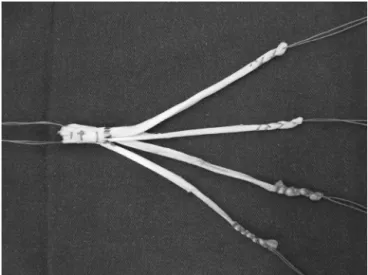w w w . r b o . o r g . b r
Original
article
Biomechanical
analysis
on
transverse
tibial
fixation
in
anterior
cruciate
ligament
reconstructions
夽
Edmar
Stieven
Filho
a,∗,
Mariane
Henseler
Damaceno
Mendes
b,
Stephanie
Claudino
b,
Filipe
Baracho
a,
Paulo
César
Borges
b,
Luiz
Antonio
Munhoz
da
Cunha
aaUniversidadeFederaldoParaná(UFPR),Curitiba,PR,Brazil
bUniversidadeTecnológicaFederaldoParaná(UTFPR),Curitiba,PR,Brazil
a
r
t
i
c
l
e
i
n
f
o
Articlehistory:
Received7November2013 Accepted6December2013 Availableonline12March2015
Keywords:
Anteriorcruciateligament Femur
Orthopedicfixationdevices Mechanics
Tendons
a
b
s
t
r
a
c
t
Objective:Toverifywhetherthecombinationoftibialcrosspinfixationandfemoralscrew fixationpresentsbiomechanicaladvantageswhencomparedtofemoralcrosspinfixation andtibialscrewfixationforthereconstructionoftheanteriorcruciateligament(ACL).
Methods:Thirty-eightporcinekneesandbovineextensordigitorumtendonswereusedas thegraftmaterials.Thetestswereperformedinthreegroups:(1)standard,usedfourteen knees,andthegraftswerefixatedwiththecombinationoffemoralcrosspinandatibial screw;(2)inverted,usedfourteenkneeswithaninvertedcombinationoftibialcrosspin anda femoralscrew;(3)control,tencontroltestsperformedwithintactACL.Afterthe graftsfixation,allthekneesweresubjectedtotensiletestingtodetermineyieldstrength andultimatestrength.
Results:Therewasnostatisticallysignificantdifferenceinsurvivaltechniquesinregardto strength,yieldloadandtension.Therewasahighersurvivalcomparedinthestandard curvesofyieldstress(p<0.05).
Conclusion:Thereisnobiomechanicaladvantage,observedinanimalmodelstesting,inthe combinationoftibialcrosspinfixationandfemoralscrewwhencomparedtofemoralcross pinfixationandtibialscrew.
©2015SociedadeBrasileiradeOrtopediaeTraumatologia.PublishedbyElsevierEditora Ltda.Allrightsreserved.
夽
WorkdevelopedattheUniversidadeFederaldoParaná(UFPR),Curitiba,PR,Brazil.ItformedpartofthedoctoralprojectofEdmar StievenFilhowithinthePostgraduateProgramonSurgeryatUniversidadeFederaldoParaná(UFPR).
∗ Correspondingauthor.
E-mails:filho2000@gmail.com,edmar.filho@ufpr.br(E.S.Filho). http://dx.doi.org/10.1016/j.rboe.2015.02.012
Análise
biomecânica
da
fixac¸ão
tibial
transversa
na
reconstruc¸ão
do
ligamento
cruzado
anterior
Palavras-chave:
Ligamentocruzadoanterior Fêmur
Dispositivosdefixac¸ão ortopédica
Mecânica Tendões
r
e
s
u
m
o
Objetivo:Investigarseafixac¸ãotransversatibialcomparafusofemoralapresentavantagens biomecânicassobreafixac¸ãotransversafemoralcomparafusotibialnareconstruc¸ãodo ligamentocruzadoanterior(LCA).
Método:Foramusadoscomomodelosdetestesjoelhossuínosetendõesextensoresdigitais bovinos.Foramsubmetidosàreconstruc¸ãodoLCA28joelhos:14foramfixadoscomparafuso natíbiaeimplantetransversonofêmur(grupopadrão)e14comparafusonofêmurefixac¸ão transversanatíbia(grupoinvertido).Osmodelosforamsubmetidosaostestesdetrac¸ão.
Resultados:Nãohouvediferenc¸aestatisticamentesignificantenasobrevivênciadastécnicas noquetangeaforc¸a,forc¸amáximasemfalhaetensão.Houveumasobrevivênciamaiorno grupopadrãonacomparac¸ãodascurvasdetensãodelimiteelástico(p<0,05).
Conclusão:Nãohávantagembiomecânicadafixac¸ãotransversatibialcomparafusofemoral em relac¸ãoàfixac¸ãotransversafemoralcomparafusotibial,observadaem testescom modelosanimais.
©2015SociedadeBrasileiradeOrtopediaeTraumatologia.PublicadoporElsevier EditoraLtda.Todososdireitosreservados.
Introduction
The treatment of choice for young active symptomatic patientswhopresentanteriorcruciateligament(ACL)injuries isreconstruction.Thisfactoristhedeterminantforobtaining betterresultsafterreturningtosportspractice.1
Thegraft fixation methodused inthe reconstruction is whatdeterminesthestabilityintheimmediatepostoperative period.Themajorityofsurgicalfailuresoccurduringtheinitial monthsandthefixationsiteisthemostvulnerablepoint.2
When grafts from knee flexors are used, it is common forthefemoralfixationtobetransverseorsuspended,and forthetibialfixationtouseinterferencescrews.Transverse andsuspendedfixationsaremoreresistantthaninterference screws.3–5
Inadditiontotheimplant,thebonequalityisalsoa deter-miningfactorforthefixation.6,7
Femoralfixationhasgreaterresistancethantibialfixation becauseoftwofactors:femoralspongybonehasgreater den-sitythanthetibialboneandthefixationusedinthefemur presentshigherresistancethanthatofthetibia.7,8
Wedidnotfindanystudiesintheliteraturethatassessed thepossibilityofcompensatingfortibialbonefragilitywith the better mechanical quality of transverse fixations, as usuallyusedinthefemur.Mostbiomechanicaltestshave eval-uatedthetibialorfemoralfixationseparately,andfewhave evaluatedthefemur-ligament-tibiacomplex.9–12
The objective of this study was to ascertain whether transversetibialfixationusingafemoralscrewpresentsany biomechanicaladvantages over transverse femoralfixation usingatibialscrew,inananimalmodel.
Material
and
methods
Thisstudywasapprovedbythelocalethicscommittee,under thenumber064/09.
Twenty-eightfreshbovinedigital extensortendonswere acquired.Theseweredissectedanddividedintotwo,inorder toformpairsandsimulatetheflexortendonsofthehuman knee.13
The extremities of each tendon were sutured using EthibondTM Polyester2surgicalthread(Johnson &Johnson,
Piscataway,NJ,USA).
Afterthe suturing,analginateimpressionwas acquired usingJeltradetypeIIwithnormalsetting(Dentsply,York,PA, USA).Thetendonwasimmersedinthispaste,which devel-opedarubberyconsistencyafterafewseconds,thusforming amold.
At this point, the tendon was removed from the algi-nateandthismoldwassectionedtransversallyintoblocksof 10mminthickness.14,15
Thesectionsgeneratedfromthealginatemoldwere digi-tizedataresolutionof600dpiusingtheHPJ5780®digitizer.
The cross-sectional areas ofthe molds were measured by meansoftheImage-ProPlus®software.
Thethinnestcross-sectionofeachoftheextremitiesofthe tendonwasselectedinordertocalculatethearea.Sincethe pairsoftendonswerefoldedinthemiddletoformquadruple grafts,thefoursmallestareasofeachoftheextremitiesofthe tendonsweresummed.
Aftertheimpressionsoftheareahadbeenmade,the ten-donswereplacedsidebysidewiththeirrespectivepair.The pairs were foldedinthe middle, thusforming the quadru-plegraft.Thequadruplegraftsweresolidifiedusingpolyester thread (EthibondTM Polyester2) at the proximal extremity
(Fig.1).15
Twenty-eightkneespecimensfrompigsoftheLargeWhite breed were dissected.16 Fourteen ofthese specimenswere
Fig.1–Solidifiedtendons–quadruplegraft.
Metalinterferencescrewsof9mmindiameterand30mm in length were used. The transverse implant consisted of a pin made of polylactic acid (Rigidfix Cross Pin System, DePuyMitek,Raynham,MA,USA).
Theentireprocessofacquiringthetendonandknee mod-els and performing the mechanical tests was carried out withina24-hourperiod,sothattherewouldnotbeanyneed tofreezethematerial,whichmighthavechangeditselastic modulusandconsequentlytheresults.Thesampleswereall keptunderrefrigeration,onice,insideplasticbags contain-ingasmallquantityof0.9%physiologicalserum,sothatthe sampleswouldnot dryout whiletheyawaitedmechanical testing.17,18
Thekneeswereplacedonaspecificsurgicaltable,inthe 90◦position.15
In both the standard and the invertedgroup, the tibial tunnelpositionwasdeterminedusingaconventionalguide configuredat55◦.Allthetunnelsweredrilledwithadiameter
of9mm.
Standard fixation Inverted fixation
W
ylliam copini. W
ylliam copini.
Fig.2–Groupswithstandardandinvertedfixation.
Femoral device Tibial device
Fig.3–Devicesforfemoralandtibialfixation.
Inthestandardgroup,thefemoraltunnelwasconstructed using a transtibialguide with anoffset of7mm.After the drilling,theguidewasplacedinaU-shape(DePuyMitek, Rayn-ham,MA,USA)inthefemurinordertoprepareforpassing thefixationpinsthrough.Thegraftwaspassedfromthetibia tothefemur. Firstly,proximalfixationusingthe transverse pins was performed and then fixation inthe tibia using a screw.15,19,20
Intheinvertedgroup,thefemoraltunnelwasconstructed usinganoutside-inguide(Phusis,Grenoble,France).21After
the tunnelshadbeendrilled, theU-shaped guidewas pos-itionedinthetibiainordertoprepareforintroductionofthe implant.Thegraft waspassedfrom thefemurtothe tibia. Firstly,thetransversefixationinthetibiawasperformedand thenthefemoralfixation.
Forboththestandardandtheinvertedgroup,a standard-ized graft length of30mm was used in the intra-articular portion.
TencontroltestswithanintactACLwerealsoperformed. Ametaldeviceforpositioningthekneesinthetestmachine was developed. Thedevice ensured the alignment and an angleof30◦betweenthefemurandthetibiaduringthetests.
Thispositioningaimedtosimulateacriticalconditionforthe ACL(Fig.3).22,23
Stabilizationwasachievedthroughfixationofthe diaph-ysisofthebonestructureinthedeviceusinganutandbolt (Fig.4).
The groupswere subjected totraction tests inthe MTS 810universaltestmachine(MaterialTestSystemCorporation, Minneapolis,MN,USA),withaloadcell ofcapacity10kg/N (newtons).
Thetraction testconditions comprisedpretensioningof 10Nandavelocityof20mm/min,untilthetendonruptured.
Thefollowingvariablesweredetermined:maximumforce (MF); maximum force without failure (MFWF), which was obtainedastheloadsupportedbythematerialuntilthefirst significantchangetothecurveofloadversusdisplacement; tension(T);tensionattheelasticlimit(TEL),i.e.thepointat whichthetendonstartedtoundergodefinitiveplastic defor-mation;andstiffness(k).
Theresultsfromthetestscomprisedvaluesforloadversus displacement.Fromthiscurve,themaximumforcesandtheir limitswithoutfailureweredetermined.
Fig.4–Positioningofthesamplesinthetestmachine.
limitweredeterminedthroughdirectratiosbetweenthe vari-ablesofforceandarea.
Thestiffnessofthefemur-ligament-tibiasystemwas deter-minedbymeansofthesecantmethod.
Forthe statisticalanalysis, nonparametric Kaplan–Meier reliabilityanalysisandthelog-ranktestwereused.The lat-tercomparedthecurvesinordertoestimatepvalues.The analyseswereperformedusingtheR3.0.2software.
Results
Theresults foundfor the standard group are described in Table1.Themeanmaximumforcewas528N,whilethe max-imumforcewithoutdetectingfailurewas352N.
Theresultsfoundfortheinvertedgrouparedescribedin Table2andthemaximumforcewithoutdetectingfailurewas 330N.
Failuresrelatingtothesurgicalprocedureortothe cou-plingofthemodeltothetestsystemwereconsideredtobe operationalfailures.Wehadonecaseineachgroupoperated inwhichthefemurbecamecrackedatthetimeoffixingthe diaphysistothe testdevice.Another fourfailuresoccurred intheinvertedgroup,throughbreakageoftheimplantduring tibialfixation.Therewerenooperationalfailuresinthecontrol group.
TheresultsfromthecontrolgrouparereportedinTable3. Tocomparetheresults,theKaplan–Meiersurvivaltestwas appliedtoMF,MFWF,TandTEL.
InthesurvivaltestusingtheFMdata,withacutoffpointof approximately450N,thesurvivalrateinthestandardgroup was69%andintheinvertedgroup,67%(p>0.05).
ForMFWF,withacutoffpointofapproximately350N,the survivalrateinthestandardgroupwas46%andintheinverted group,33%(p>0.05).
Attheloadsof450NforMFand350NforFMWF,the con-trolgrouppresentedsurvivalof100%,whichwasstatistically significantincomparisonwitheitheroftheothertwogroups (p<0.05).
In the tensionanalysis, a cutoffpointof approximately 10MPa(megapascals),thesurvivalratewasfoundtobe69% inthestandardgroupand67%intheinvertedgroup(p>0.05). For TEL, at a cutoff point of approximately 7MPa, the survival rate was 62% in the standard group and 22% in the invertedgroup. This result was statistically significant (p<0.05).
Discussion
The traction test was performed through gradually apply-ing a deformational force tothe sample, until it ruptured. Theforcewasappliedtothelongaxisofthetestbody.The testmachinemeasuredtheinstantaneousloadappliedand thedisplacement.Thetestbodywasstretchedataconstant
Table1–Standardgroup:transversefemoralpinandtibialinterferencescrew.
MFWF(N) MF(N) A(mm2) T(N) TEL(N) k(N/mm) Failuresite
Transverse Screw Operational
Median 350 528 46 11 8 43 0 13 1
Mean 352 528 48 11 8 43
SD 108 96 10 3 3 15
MF,maximumforce;MFWF,maximumforcewithoutfailure;T,tension;TEL,tensionatelasticlimit;k,stiffness;SD,standarddeviation;N, newtons;A,area.
Table2–Invertedgroup:femoralinterferencescrewandtransversetibialpin.
MFWF(N) MF(N) A(mm2) T(N) TEL(N) k(N/mm) Failuresite
Transverse Screw Operational
Median 280 496 46 10 6 45 2 7 5
Mean 330 511 49 11 6 47
SD 109 117 11 1 2 14
Table3–Controlgroup.
MFWF(N) MF(N) Failuresite
Tibia Femur Fracture
Median 755 1032 8 1 1
Mean 780 986
SD 108 129
MF,maximumforce;MFWF,maximumforcewithoutfailure;SD, standarddeviation;N,newtons.
ratebytheequipment.Thesetractiontestsweredestructive tests.15
Thenumberofoperationalfailuresintheinvertedgroup (five)wasgreaterthanthenumberinthestandardgroup(one). Therewasonecaseoffailureofthefixationinthetraction machineineachgroup.Thesurgicalfailuresoccurredinthe invertedgroup. Thisoccurred because the guide for trans-versetibialfixationhadbeenadaptedfromtheoneusedfor thefemur.Theseadaptationsdonothavethesamelevelof reproducibility as seen with specific materials. Theguides forimplantation ofthe pins inthe tibia became unstable, whichledtobreakageoftheimplantatthetimewhenitwas introduced.
Therupturingofthegraftsinthestandardgroupoccurred atthescrew.Intheinvertedgroup,thereweretwocasesof fail-ureofthetransversefixation.Thisshowsthatthescrewhad greatermechanicalfragilitythandidthetransversefixation.
Regardingthetwocasesoffailureofthetransverse fixa-tionintheinvertedgroup,threehypothesescanbeenvisaged. Oneisthatthescrewintheoutside-inpositioninghadgreater resistanceinthetractionplanetested,sinceitwastestedat adivergentangle.Thesecondisthatthebonequalityofthe spongyboneofthefemurincreasedtheresistanceofthe fixa-tion.Lastly,thefactthattheguideforfixationofthetransverse tibialimplanthadbeenadaptedmayhavebeenthedecisive factorforthesetwofailures.
Transversefixationisusedinthefemurfortechnical rea-sons,toavoidthedifficultiesofplacingascrewinthefemur anditscomplications.Thisscrewisintroducedthroughthe medialportaland crossesthe intercondylarregion.Itoften hastobeplacedinatunnelatananglethatdiffersfromthat oftheentryportaloftheimplant.24,25Transversefixationand
suspendedfixationmakefemoralfixationasimplersurgical step.
Despitepresentinggreaterresistancethanthatofscrews, bothtransversefixationandsuspendedfixationhavetheir dis-advantages.Theirhighmechanicalresistanceisonlyreached ifaloop ofquadrupletendonisused.Attheother extrem-ity,theiruseislimited.Inthesefixations,cautionisrequired inrelationtothediameterofthetunnel,sincetunnelsthat areverywide maydiminishthe mechanicalresistanceand graft-bonecontact.26
In the outside-in technique, the femoral screw is introduced through a lateral access into the femur, which takesawaymanycomplicatingfactorsfromfemoralfixation withascrew.21
Anassociation betweenthe technical easeof fixingthe femurusinganoutside-inscrewandthemechanical
advan-tageoftransversetibialfixation,inordertocompensatefor thelowqualityofthespongybone,seemstobepromising.The presentstudydidnotshowthispossiblemechanical advan-tageinanimalmodels.
Survivaltestsare idealforcomparingmechanical analy-sesonsurgicaltechniques.15Theyshowthedegreetowhicha
givenprocedurecanbetrusted,forthedifferentloadsapplied. Nostatistical differenceswere foundin relationtothe MF, MFWF or Tdata. However,inrelationtothe TEL data, the standardgrouppresentedgreatersurvival.Thisshowsthatin additiontothelackofadvantageinusingtransversefixation in the tibia, this method may signify diminished capacity towithstandthetension.Onehypothesisforexplainingthis resultliesintheuseofguidesadaptedfromthefemoralregion forthetibialregion.
DespitethenegativefindinginrelationtoTEL,therehave been clinical studies showingthat use of transverse tibial fixation is safe.27 Good results from mechanical tests on
transversetibialfixationcanalsobefoundintheliterature. However,nopreviousstudieshavetestedthe femur-ligament-tibia complex;rather,theyonlyevaluatedthe tibialregion. Anotherimportantpointisthatwedidnotfindanystudies that hadevaluated Tor TELinrelationtotransverse tibial fixation.12
Conclusion
Thereisnobiomechanicaladvantagefromtransversetibial fixationusingafemoralscrew,incomparisonwithtransverse femoralfixationusingatibialscrew,asobservedintestson ananimalmodelforACLreconstruction.Thereisthe possi-bilitythatthegroupwithtransversetibialfixationhaslower capacitytowithstandtension.
Conflicts
of
interest
Theauthorsdeclarenoconflictsofinterest.
r
e
f
e
r
e
n
c
e
s
1.CohenM,AbdallaRJ,EjnismanB,FilardiM.Estudo
comparativonotratamentodaslesõesdoligamentocruzado anteriornoesporte.RevBrasOrtop.1977;32(35):337–41. 2.NoyesFR,Barber-WestinSD.Revisionanteriorcruciate
ligamentreconstruction:reportof11-yearexperienceand resultsin114consecutivepatients.InstrCourseLect. 2001;50:451–61.
3.MilanoG,MulasPD,ZiranuF,PirasS,ManuntaA,Fabbriciani C.Comparisonbetweendifferentfemoralfixationdevicesfor ACLreconstructionwithdoubledhamstringtendongraft:a biomechanicalanalysis.Arthroscopy.2006;22(6):
660–8.
4.KousaP,JärvinenTLN,VihavainenM,KannusP,JärvinenM. Thefixationstrengthofsixhamstringtendongraftfixation devicesinanteriorcruciateligamentreconstruction.PartI: Femoralsite.AmJSportsMed.2003;31(2):182–8.
5.SchefflerSU,SüdkampNP,GöckenjanA,HoffmannRFG, WeilerA.Biomechanicalcomparisonofhamstringand patellartendongraftanteriorcruciateligament
fixationmethodundercyclicloading.Arthroscopy. 2002;18(3):304–15.
6. RodeoSA,ArnoczkySP,TorzilliPA,HidakaC,WarrenRF. Tendon-healinginabonetunnel.Abiomechanicaland histologicalstudyinthedog.JBoneJointSurgAm. 1993;75(12):1795–803.
7. NurmiJT,SievänenH,KannusP,JärvinenM,JärvinenTLN. Porcinetibiaisapoorsubstituteforhumancadavertibiafor evaluatinginterferencescrewfixation.AmJSportsMed. 2004;32(3):765–71.
8. BrandJC,PienkowskiD,SteenlageE,HamiltonD,JohnsonDL, CabornDN.Interferencescrewfixationstrengthofa
quadrupledhamstringtendongraftisdirectlyrelatedtobone mineraldensityandinsertiontorque.AmJSportsMed. 2000;28(5):705–10.
9. MonacoE,LabiancaL,SperanzaA,AgròAM,CamillieriG, D’ArrigoC,etal.Biomechanicalevaluationofdifferent anteriorcruciateligamentfixationtechniquesforhamstring graft.JOrthopSci.2010;15(1):125–31.
10.AgaC,RasmussenMT,SmithSD,JanssonKS,LapradeRF, EngebretsenL,etal.Biomechanicalcomparisonof interferencescrewsandcombinationscrewandsheath devicesforsofttissueanteriorcruciateligament reconstructiononthetibialside.AmJSportsMed. 2013;41(4):841–8.
11.PetreBM,SmithSD,JanssonKS,deMeijerP-P,HackettTR, LapradeRF,etal.Femoralcorticalsuspensiondevicesforsoft tissueanteriorcruciateligamentreconstruction:a
comparativebiomechanicalstudy.AmJSportsMed. 2013;41(2):416–22.
12.ZantopT,WeimannA,RümmlerM,HassenpflugJ,Petersen W.Initialfixationstrengthoftwobioabsorbablepinsforthe fixationofhamstringgraftscomparedtointerferencescrew fixation:singlecycleandcyclicloading.AmJSportsMed. 2004;32(3):641–9.
13.DonahueTL,GregersenC,HullMLHS.Comparisonof viscoelastic,structural,andmaterialpropertiesof double-loopedanteriorcruciateligamentgraftsmadefrom bovinedigitalextensorandhumanhamstringtendons.J BiomechEng.2001;123(2):162–9.
14.GoodshipAE,BirchHL.Crosssectionalareameasurementof tendonandligamentinvitro:asimple,rapid,non-destructive technique.JBiomech.2005;38(3):605–8.
15.StievenFilhoE,MalafaiaO,Ribas-FilhoJM,DinizOEDS,Borges PC,AlbanoM,etal.Biomechanicanalysisofthesewed tendonsforthereconstructionoftheanteriorcruciate ligament.RevColBrasCir.2010;37(1):52–7.
16.NagarkattiDG,McKeonBP,DonahueBS,FulkersonJP. Mechanicalevaluationofasofttissueinterferencescrewin freetendonanteriorcruciateligamentgraftfixation.AmJ SportsMed.2001;29(1):67–71.
17.ViegasAC,CamanhoGL.Avaliac¸ãobiomecânicadostendões dosmúsculostibiaisepropostadesuautilizac¸ãocomo aloenxertosnasreconstruc¸õesdoligamentocruzado anterior.ActaOrtopBras.2003;11(3):170–5.
18.MatthewsLS,EllisD.Viscoelasticpropertiesofcattendon: effectsoftimeafterdeathandpreservationbyfreezing.J Biomech.1968;1(2):65–71.
19.FaustinoCAC.Reconstruc¸ãodoLCAcomousodostendões dosmúsculosflexoresmediaisdojoelhoefixac¸ãofemoral comosistemadeRigidifix®:relatopreliminar.ActaOrtop Bras.2004;12(4):212–6.
20.JonesKG.Reconstructionoftheanteriorcruciateligament.A techniqueusingthecentralone-thirdofthepatellar ligament.JBoneJointSurgAm.1963;45:925–32.
21.GarofaloR,MouhsineE,ChambatP,SiegristO.Anatomic anteriorcruciateligamentreconstruction:thetwo-incision technique.KneeSurgSportsTraumatolArthrosc.
2006;14(6):510–6.
22.MiyataK,YasudaK,KondoE,NakanoH,KimuraS,HaraN. Biomechanicalcomparisonsofanteriorcruciateligament: reconstructionprocedureswithflexortendongraft.JOrthop Sci.2000;5(6):585–92.
23.WooSL,HollisJM,AdamsDJ,LyonRM,TakaiS.Tensile propertiesofthehumanfemur-anteriorcruciate ligament-tibiacomplex.Theeffectsofspecimenageand orientation.AmJSportsMed.1991;19(3):217–25. 24.WaltonM.Absorbableandmetalinterferencescrews:
comparisonofgraftsecurityduringhealing.Arthroscopy. 1999;15(8):818–26.
25.MilankovMZ,MiljkovicN,NinkovicS.Femoralguide breakageduringtheanteromedialportaltechniqueusedfor ACLreconstruction.Knee.2009;16(2):165–7.
26.SimonianPT,EricksonMS,LarsonRV,O’KaneJW.Tunnel expansionafterhamstringanteriorcruciateligament reconstructionwith1-incisionEndoButtonfemoralfixation. Arthroscopy.2000;16(7):707–14.
27.VolpiP,MarinoniL,BaitC,GalliM,deGirolamoL.Tibial fixationinanteriorcruciateligamentreconstructionwith bone-patellartendon-boneand

